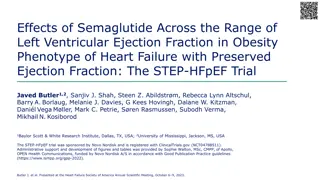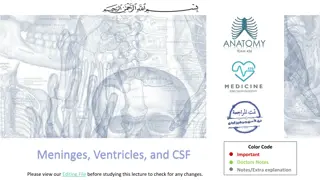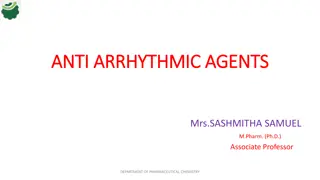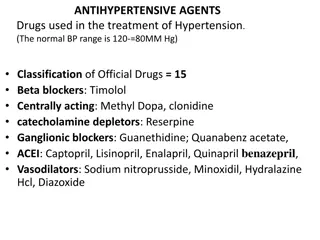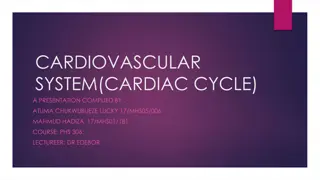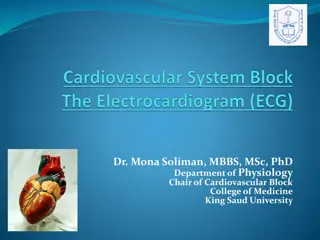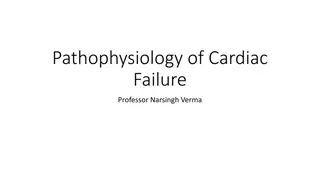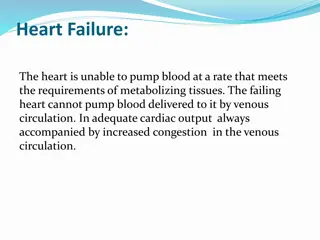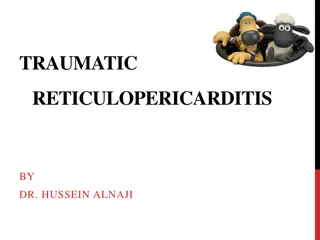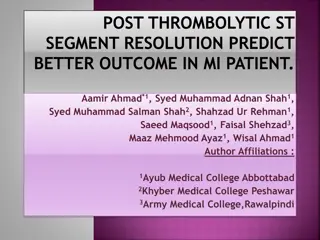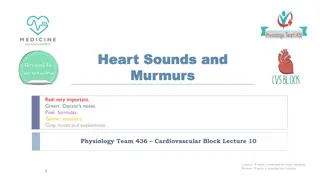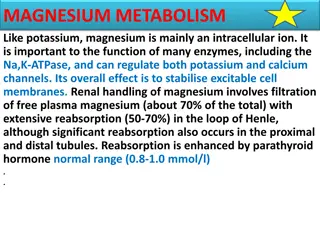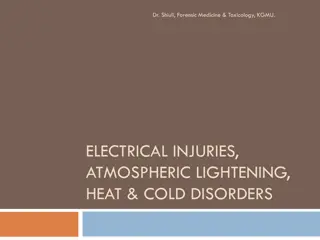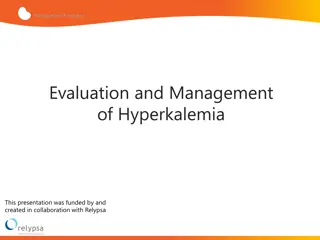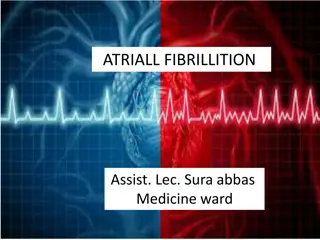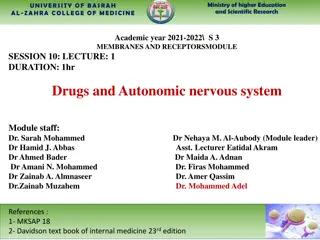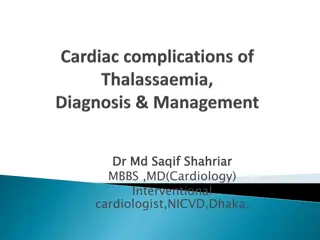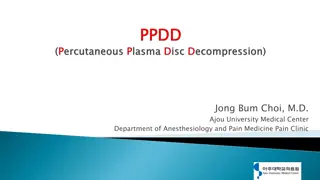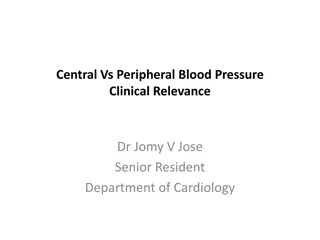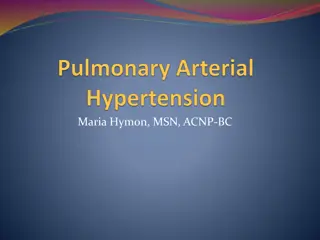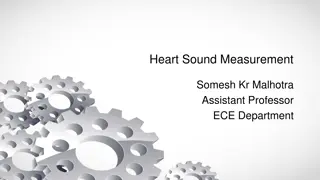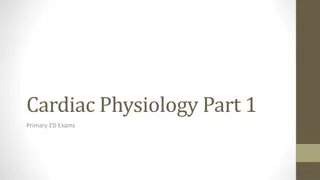Advanced Cardiovascular Life Support Algorithm
This advanced cardiovascular life support algorithm provides step-by-step guidance in managing cardiac emergencies such as cardiac arrest, arrhythmias, and other life-threatening conditions. The algorithm includes a series of slides detailing important procedures and interventions to improve patient
5 views • 9 slides
Effects of Semaglutide on Heart Failure with Preserved Ejection Fraction
The STEP-HFpEF trial investigated the impact of semaglutide on heart failure with preserved ejection fraction (HFpEF) across different left ventricular ejection fraction (LVEF) ranges. Results showed significant improvements in symptoms, physical limitations, exercise function, inflammation, and wei
4 views • 19 slides
Emergency Drugs and Their Mechanisms of Action
Learn about essential emergency drugs such as Adrenaline, Adenosine, Atropine, Furosemide, Calcium Gluconate, and Lidocaine. Understand their mechanisms of action, dosages, indications, and onset times to effectively manage cardiac arrest, anaphylaxis, arrhythmias, and other critical conditions.
3 views • 17 slides
Understanding Ventricular Septal Defect (VSD) and Treatment Options
Ventricular Septal Defect (VSD) is a common congenital heart condition characterized by a hole in the septum between the heart's ventricles. This defect can lead to various complications and is often associated with chromosomal disorders. Different types of VSD exist, each requiring tailored treatme
6 views • 72 slides
Antiarrhythmics
Cardiac arrhythmias are a common cause of death in patients with heart conditions. These abnormalities in heart rhythm can be due to issues with impulse generation or conduction. Antiarrhythmic medications play a crucial role in managing these conditions by affecting the action potentials of cardiac
3 views • 14 slides
Empagliflozin Effects on Heart Failure with Reduced Ejection Fraction: EMPEROR-Reduced Trial Overview
Empagliflozin's impact on cardiovascular and renal events in heart failure with reduced ejection fraction was assessed in the EMPEROR-Reduced trial led by Milton Packer, MD, and Faiez Zannad, MD. The trial, enriched for patients with severe left ventricular dysfunction, randomized participants to em
2 views • 22 slides
Understanding the Meninges, Ventricles, and CSF in the Central Nervous System
The lecture covers the cerebral and spinal meninges, emphasizing the dura, arachnoid, and pia mater layers. It explores the significance of the subarachnoid space and the ventricular system in the CNS, including CSF formation, circulation, and clinical implications.
0 views • 18 slides
Understanding Anti-Arrhythmic Agents in Cardiac Care
Anti-arrhythmic agents are crucial in managing abnormal heart rhythms like atrial fibrillation and ventricular tachycardia. Causes of arrhythmias vary from heart anatomy changes to medication side effects. Factors like exertion, imbalances in blood chemistry, and medication use can trigger arrhythmi
0 views • 39 slides
Overview of Antihypertensive Agents and their Mechanisms of Action
Explore the classification of antihypertensive agents used in treating hypertension, including beta blockers, centrally acting agents, ganglionic blockers, ACE inhibitors, vasodilators, and more. Learn about the Renin-Angiotensin System, ACE inhibitors, and specific drugs like Captopril and Benazepr
0 views • 9 slides
Understanding the Cardiac Cycle: A Comprehensive Overview
The cardiac cycle, involving systole and diastole processes, consists of arterial and ventricular events essential for heart function. Arterial events include systole and diastole, while ventricular events encompass isometric contraction, ejection period, prodiastole, isometric relaxation, rapid fil
2 views • 8 slides
Understanding the Normal Electrocardiogram (ECG) in Cardiovascular Physiology
Dr. Mona Soliman, MBBS, MSc, PhD from King Saud University explains the waves, intervals, and leads of a normal ECG in detail. The ECG records the heart's electrical activity, showcasing depolarization and repolarization waves. Learn about P-wave (atrial depolarization), QRS complex (ventricular dep
1 views • 24 slides
Clinical ECG Interpretation Elective: Learning Objectives and Activities
This rotation aims to enhance clinical skills in ECG interpretation with a focus on myocardial and conduction abnormalities, arrhythmias, and tachycardias. Students will engage in e-learning modules, case studies, and literature reviews to master ECG analysis. The course emphasizes patient care, med
0 views • 10 slides
Pathophysiology of Cardiac Failure and Adaptive Mechanisms of the Heart
Cardiac failure is a condition where the heart is unable to meet tissue metabolic needs despite normal or increased venous return. Causes include decreased contractility, coronary blood flow, damaged valves, and more. Normal resting cardiac output is 5 Lt/mts, with adaptive mechanisms like the Frank
0 views • 35 slides
Chronic Primary Mitral Regurgitation: Evaluation and Management Considerations
Chronic primary mitral regurgitation (MR) presents various considerations in evaluating severity, symptoms, left ventricular function, and candidacy for mitral valve repair. The management decision involves assessing imaging findings, LV function, and the impact on mortality and quality of life. Sur
0 views • 9 slides
Understanding Heart Failure and Congenital Heart Diseases
Heart failure is a condition where the heart struggles to pump blood efficiently, leading to various complications. It can affect different sides of the heart, with causes ranging from coronary artery disease to valve problems. Congenital heart diseases, on the other hand, are common anomalies prese
0 views • 19 slides
Traumatic Reticulopericarditis in Livestock: Causes, Symptoms, and Management
Traumatic reticulopericarditis in livestock is caused by penetration of the pericardial sac by a migrating metal foreign body, leading to pericarditis, toxemia, and congestive heart failure. Clinical signs include depression, anorexia, respiratory distress, and bilateral jugular distension. If chron
0 views • 13 slides
Thrombolytic ST Segment Resolution Predicts Better Outcome in MI Patients
Acute myocardial infarction (AMI), commonly known as a heart attack, occurs when blood flow to a part of the heart is blocked, leading to heart muscle injury. Resolution of ST segment elevation on electrocardiogram after thrombolytic therapy can predict final infarct size, left ventricular function,
0 views • 24 slides
Understanding Heart Sounds and Murmurs in Cardiovascular Physiology
This detailed lecture covers the basics of normal and abnormal heart sounds, stethoscope placement, cardiac auscultation, and the physiological significance of heart murmurs. It explains the causes, descriptions, and grading of abnormal heart sounds, along with specific conditions like aortic stenos
0 views • 26 slides
Understanding Magnesium Metabolism and Hypomagnesaemia
Magnesium, mainly an intracellular ion, plays a crucial role in enzyme function and cell membrane stability. Its renal handling involves filtration and reabsorption, with hypomagnesaemia often linked to hypocalcaemia. Causes include inadequate intake, excessive losses from GI and urinary sources, an
0 views • 17 slides
Electrical Injuries: Causes, Effects, and Post-Mortem Findings
Dr. Shiuli from KGMU specializes in Forensic Medicine & Toxicology, focusing on the impact of electrical injuries such as ventricular fibrillation, thermal injuries, and post-mortem findings like external marks and histological changes. Detailed insights on path of current, causes of death, flash bu
0 views • 28 slides
Understanding Hyperkalemia: Causes, Evaluation, and Management
Hyperkalemia is a condition characterized by elevated serum potassium levels, posing serious risks such as cardiac arrhythmias and sudden death. Pathogenesis involves factors like abnormal potassium release, impaired distribution, and excretory process impairment. Causes range from pseudohyperkalemi
0 views • 35 slides
Clinical Cases and Image Findings in Cardiology and Neurology
Explore a collection of clinical cases and image findings covering topics such as widened mediastinum, tracheal deviation, subdural hematoma, myocardial infarction, and arrhythmias. Learn about different diagnostic modalities, operative treatments, and potential complications associated with these c
0 views • 17 slides
Atrial Fibrillation Overview: Symptoms, Treatment, and Management
Heart Failure (HF) is increasingly recognized as a cause of Atrial Fibrillation (AF). The goals of individualized therapy for AF include ventricular rate control, restoration of sinus rhythm, maintenance of sinus rhythm, and prevention of stroke. Hemodynamically unstable AF requires emergent convers
0 views • 29 slides
Understanding Autonomic Nervous System and Clinical Applications in Medicine
This academic session covers the effect of autonomic nervous system stimulation on various systems, clinical diseases, pathophysiological changes, disease management guidelines, and clinical applications of autonomic drugs. Common clinical applications of autonomic receptors agonists and antagonists
0 views • 23 slides
Understanding Cardiovascular Complications of Thalassaemia
Cardiovascular complications of thalassaemia can be categorized into iron overload-related issues such as myocyte failure and arrhythmias, and non-iron overload complications including pulmonary hypertension and atrial fibrillation. Cardiac iron accumulation poses a significant risk, leading to card
0 views • 36 slides
Ablation Techniques in Medical Practice
Ablation procedures like PPDD and Coagulation are effective methods for treating various conditions such as cardiac arrhythmias, tumors, and wound debridement. RF ablation offers advantages such as precise targeting, lower tissue temperatures, and tissue preservation at the molecular level. Understa
0 views • 33 slides
Understanding Central vs Peripheral Blood Pressure: Clinical Relevance
Central vs peripheral blood pressure differences have clinical implications as systolic pressure amplification occurs due to changes in arterial stiffness moving away from the heart. Central pressure measurements, more closely related to cardiovascular events, provide valuable insights for assessing
3 views • 25 slides
Understanding Haemodynamic Consequences of Acute Pulmonary Embolism
Haemodynamic consequences of acute pulmonary embolism (PE) include increased mean pulmonary artery pressure, rise in right ventricular preload and end-diastolic pressure, risk of right ventricular failure, and decreased pulmonary blood flow leading to low systolic blood pressure. Arterial hypoxia ca
0 views • 18 slides
Understanding Pulmonary Arterial Hypertension (PAH): Causes, Symptoms, and Management
Pulmonary Arterial Hypertension (PAH) is a progressive disease characterized by increased blood pressure in the pulmonary artery, veins, or capillaries. This condition can lead to right ventricular failure and eventual death if left untreated. PAH can have various causes, including idiopathic factor
0 views • 49 slides
Understanding Heart Sound Measurement in Cardiac Auscultation
Heart sound measurement plays a crucial role in cardiac auscultation. This process involves listening to the four basic heart sounds produced by various mechanisms in the heart, such as valve closure, abnormal valve opening, ventricular chamber vibrations, chordae tendineae tension, and turbulent bl
0 views • 5 slides
Understanding Cardiac Physiology: Electrical System and Excitation
Explore the intricate details of cardiac physiology, focusing on the electrical conducting system, spread of excitation, ECG interpretation, action potentials, and hemodynamic parameters. Learn about pacemaker cells, differences between ventricular and pacemaker action potentials, and the initiation
0 views • 26 slides

